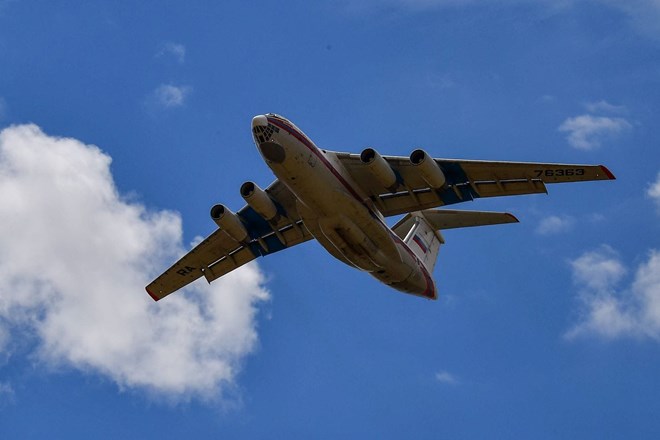
Saturday July 13, 2019

A Russian AN-124 cargo plane transporting parts of the S-400 air defense system from Russia lands Friday at Murted airfield in Ankara, Turkey. (Getty Images)
A Russian plane carrying the first components of the S-400 surface-to-air defense system landed in Turkey on Friday, in a move that is opposed by the Pentagon and could damage Turkey’s relationship with the United States and other NATO allies.
Washington has long warned that if Turkey were to acquire the Russian system, the United States may impose harsh economic sanctions and revoke Turkey’s participation in U.S. military programs.
Here are some key questions and answers about how the S-400 ended up in Turkey and what may come next:
What is the S-400 air and missile system?
It’s a Russian-made, long-range, surface-to-air defense system. The S-400 is one of Russia’s most sophisticated pieces of military equipment, with advanced surveillance radar and a suite of missiles that can closely track and target aircraft from the ground.
Turkish President Recep Tayyip Erdogan has said he chose to go ahead with the $2.5 billion purchase from Russia because the United States did not make an adequate offer on its own Patriot air defense system. NATO has that system stationed in Turkey for its own purposes in Syria, but Turkey never purchased it from Washington. NATO officials have raised concerns that the S-400 purchase will not be compatible with other systems already in use in Turkey.
Why is the United States opposed to Turkey owning the S-400 system?
Turkey previously ordered about 100 F-35 stealth jet fighters from the United States, and almost 1,000 parts of the jet are made by Turkish companies. U.S. officials fear that if Turkey has both the F-35 and Russia’s most advanced air defense system in its hands, then the Russians may gain access to F-35 technology and learn how to target its weaknesses.
In late May, Kathryn Wheelbarger, U.S. acting assistant secretary of defense, said that the “S-400 is a
Russian system designed to shoot down an aircraft like the F-35.”
She said “it is inconceivable to imagine Russia not taking advantage of that [intelligence] collection opportunity.”
Last week, Pentagon spokesman Lt. Col. Mike Andrew said that “Turkey will not be permitted to have both systems.”
The episode has put the United States in an uncomfortable bind. Washington is eager to prevent Russia from having access to its advanced military equipment, but the United States also relies heavily on Turkey as an important partner in the region because of its strategic location bordering Iraq, Iran and Syria.
Does the S-400 pose a risk to the F-35?
Not at the moment. Past estimates suggested that the radar systems on the S-400 can identify an F-35 once it is within about 20 miles, but the F-35 carries air-to-ground missiles with a range of up to 40 miles that could destroy it.
U.S. officials have expressed concern that if the two systems are in proximity, the Russian system could learn more about the F-35′s stealth capabilities. Experts on weapons systems say that having the S-400 in proximity to the F-35 could help Russia develop the ability to better detect the American aircraft on radar. And by having more data from an F-35, S-400 owners and operators might be able to find the planes’ weak spots.
What has Washington threatened to do about it?
U.S. officials have previously threatened to cancel shipments of F-35 jets to Ankara and impose economic sanctions on Turkey through the 2017 Countering America’s Adversaries Through Sanctions Act.
And in April, the Pentagon announced that it was suspending Turkey’s participation in a program that trains pilots from U.S. allies to fly the F-35 until Turkey agreed to cancel the purchase of the S-400 system.
But at the Group of 20 meeting in Japan last month, President Trump blamed the dispute on the Obama administration, saying, “It’s not really Erdogan’s fault.” He also said he didn’t think the United States would impose sanctions on Turkey over the issue.
U.S. lawmakers from both sides of the aisle have opposed Turkey having both the S-400 system and F-35 jets.
How has Turkey defended its decision to go forward with the purchase?
Erdogan has said acquiring the Russian system is in line with Turkey’s sovereign right to defend itself.
Last month, Erdogan urged the United States to not let the purchase of the S-400 deteriorate strong ties between the two countries. “They should think deeply, because losing a country like Turkey will not be easy,” Erdogan said, referring to officials in Washington. “If we are friends, if we are strategic partners, then we should handle this issue between each other.”
Turkey also said it would keep the U.S. and Russian equipment separate to avoid allowing Russian access to U.S. stealth technology.
Erdogan has expressed confidence that his relationship with Trump will override U.S. sanctions concerns.
“I say this very openly and sincerely, our relations with Trump are at a place that I can call really good,” Erdogan said in June. “In the event of any issues, we immediately work the phones.”
What has NATO said about all this?
On Friday, a NATO official told The Washington Post that the alliance was “concerned about the potential consequences of Turkey’s decision to acquire the S-400 system. Interoperability of our armed forces is fundamental to NATO for the conduct of our operations and missions.”
Could other countries follow Turkey’s lead?
Most countries that already have S-400s are in adversarial relationships with the United States — China, for example, owns the system.
But besides Turkey, other nations that buy high-tech arms from the United States have indicated they would like to buy the S-400, too. This week, the Indian government reaffirmed to the United States its intention to buy the system, and Qatar, another U.S. ally, has suggested it may also seek to purchase S-400s.
Adam Taylor contributed to this report.